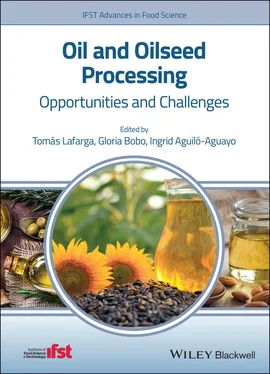Rapeseed oil and soybeans are the main oilseed crops for the production of biodiesel in Europe and the United States, respectively. However, other emerging oilseed crops such as mustard or hazelnuts are being explored as promising biodiesel feedstocks (Farm Energy 2019). In the case of rapeseed oil, the production of biodiesel is made through the rapeseed oil methyl ester with a limitation value of contamination lower than 25 mg/kg according to the “Quality standard for rapeseed oil as a fuel” (Fetzer et al. 2018; USDA 2019).
Ingrid Aguiló‐Aguayo thanks the National Programme for the Promotion of Talent and Its Employability of the “Ministerio de Economía, Industria y Competitividad” of the Spanish Government and the European Social Fund for the Postdoctoral Senior Grant “Ramon y Cajal” (RYC‐2016‐19949). This work was supported by the CERCA Programme of Generalitat de Catalunya.
1 Akram, S., Siddiqui, M.N., Hussain, B.N. et al. (2017). Exogenous glutathione modulates salinity tolerance of soybean [Glycine max (L.) Merrill] at reproductive stage. Journal of Plant Growth Regulation 36 (4): 877–888.
2 Alajtal, A.I., Sherami, F.E., and Elbagermi, M.A. (2018). Acid, peroxide, ester and saponification values for some vegetable oils before and after frying. AASCIT Journal of Materials 4 (2): 43–47.
3 Amira, P.O., Babalola, O., and Oyediran, A. (2014). Physicochemical properties of palm kernel oil. Current Research Journal of Biological Sciences 6 (5): 205–207.
4 Azlan, A., Prasad, K.N., Khoo, H.E. et al. (2010). Comparison of fatty acids, vitamin E and physicochemical properties of Canarium odontophyllum Miq.(dabai), olive and palm oils. Journal of Food Composition and Analysis 23 (8): 772–776.
5 Azzeme, A.M., Abdullah, S.N.A., Aziz, M.A. et al. (2016). Oil palm leaves and roots differ in physiological response, antioxidant enzyme activities and expression of stress‐responsive genes upon exposure to drought stress. Acta Physiologiae Plantarum 38 (2): 52.
6 Bailey, A.E. and Shahidi, F. (2005). Bailey's Industrial Oil & Fats Products. Chichester: Wiley.
7 Balasubramaniam, V.G., Sathvika, S., Ayyappan, P. et al. (2020). Improved oxidative stability of peanut oil through addition of finger millet (Eleusine coracana) seed coat polyphenols. Journal of Food Process Engineering 43 (3): e13194.
8 Balbino, S. (2017). Vegetable oil yield and composition influenced by environmental stress factors. In: Oilseed Crops: Yield and Adaptations Under Environmental Stress (ed. P. Ahmad), 80–101. Chichester: John Wiley & Sons.
9 Barcelos, E., Rios, S.d.A., Cunha, R.N. et al. (2015). Oil palm natural diversity and the potential for yield improvement. Frontiers in Plant Science 6: 190.
10 Bauer, B. and Kostik, V. (2014). The content of saturated, monounsaturated and polyunsaturated fatty acids in the seeds of different canola varieties. In: Proceedings of the Eighth Conference on Medicinal and Aromatic Plants of Southeast European Countries (eds. Z.D. Stevanović and A. Ibraliu). Belgrade: Academy of Science of Albania, Agricultural University of Tirana and Association for Medicinal and Aromatic Plants of Southeast European Countries (AMAPSEEC).
11 Bernard, J.K. (2016). Oilseed and oilseed meals. In: Reference Module in Food Science (ed. G.W. Smithers). Amsterdam: Elsevier.
12 Beszterda, M. and Nogala‐Kałucka, M. (2019). Current research developments on the processing and improvement of the nutritional quality of rapeseed (Brassica napus L.). European Journal of Lipid Science and Technology 121 (5): 1800045.
13 Birch, E.E., Garfield, S., Hoffman, D.R. et al. (2000). A randomized controlled trial of early dietary supply of long‐chain polyunsaturated fatty acids and mental development in term infants. Developmental Medicine and Child Neurology 42 (3): 174–181.
14 Bishop, G.J. and Yokota, T. (2001). Plants steroid hormones, brassinosteroids: current highlights of molecular aspects on their synthesis/metabolism, transport, perception and response. Plant and Cell Physiology 42 (2): 114–120.
15 Broschat, T.K. and Crane, J.H. (2017). The Coconut Palm in Florida. Gainseville, FL: Institute of Food and Agricultural Sciences (IFAS), HS40.
16 Burgal, J., Shockey, J., Lu, C. et al. (2008). Metabolic engineering of hydroxy fatty acid production in plants: RcDGAT2 drives dramatic increases in ricinoleate levels in seed oil. Plant Biotechnology Journal 6 (8): 819–831.
17 Campillo, C., Fortes, R., Prieto, M.D.H. et al. (2012). Solar radiation effect on crop production. Solar Radiation 1: 494.
18 Canada, H. (2016). Consultation on the health implications of alternatives to trans fatty acids: summary of responses from experts. https://web.archive.org/web/20070225021532/http:/www.hc‐sc.gc.ca/fn‐an/nutrition/gras‐trans‐fats/tf‐ge/tf‐gt_app9iii_e.html(accessed March 12, 2020).
19 Carelli, A.A., Brevedan, M.I., and Crapiste, G.H. (1997). Quantitative determination of phospholipids in sunflower oil. Journal of the American Oil Chemists' Society 74 (5): 511–514.
20 Carelli, A.A., Franco, I.C., and Crapiste, G.H. (2005). Effectiveness of added natural antioxidants in sunflower oil. Grasas y Aceites 56 (4): 303–310.
21 Chadwick, S.S. (1988). Ullmann's encyclopedia of industrial chemistry. Reference Services Review 16 (4): 31–34.
22 Chatepa, L.E.C., Uluko, H., and Masamba, K. (2019). Comparison of oil quality extracted from selected conventional and non conventional sources of vegetable oil from Malawi. African Journal of Biotechnology 18 (8): 171–180.
23 Cheema, M., Malik, M., Hussain, A. et al. (2001). Effects of time and rate of nitrogen and phosphorus application on the growth and the seed and oil yields of canola (Brassica napus L.). Journal of Agronomy and Crop Science 186 (2): 103–110.
24 Chen, Y., Cao, Y., Zhao, L. et al. (2014). Macronutrients and micronutrients of soybean oil bodies extracted at different pH. Journal of Food Science 79 (7): C1285–C1291.
25 Chew, S.C. (2020). Cold‐pressed rapeseed (Brassica napus) oil: chemistry and functionality. Food Research International 131: 108997.
26 Chivandi, E., Davidson, B.C., and Erlwanger, K.H. (2008). A comparison of the lipid and fatty acid profiles from the kernels of the fruit (nuts) of Ximenia caffra and Ricinodendron rautanenii from Zimbabwe. Industrial Crops and Products 27 (1): 29–32.
27 Ciannamea, E.M., Castillo, L.A., Barbosa, S.E. et al. (2018). Barrier properties and mechanical strength of bio‐renewable, heat‐sealable films based on gelatin, glycerol and soybean oil for sustainable food packaging. Reactive and Functional Polymers 125: 29–36.
28 Diepenbrock, W. (2000). Yield analysis of winter oilseed rape (Brassica napus L.): a review. Field Crops Research 67 (1): 35–49.
29 Díez, C.M., Moral, J., Cabello, D. et al. (2016). Cultivar and tree density as key factors in the long‐term performance of super high‐density olive orchards. Frontiers in Plant Science 7: 1226.
30 Dunford, N.T. (2004). Oil‐and oilseed‐based bioactive compounds and their health effects. In: Nutritionally Enhanced Edible Oil and Oilseed Processing (eds. N.T. Dunford and H.B. Dunford), 1–24. Champaign, IL: AOCS Press.
31 Dunford, N.T. and Dunford, H.B. (2004). Nutritionally Enhanced Edible Oil and Oilseed Processing. Champain, IL: AOCS Press.
32 Dupont, J. (2003). Vegetable oils: dietary importance. In: Encyclopedia of Food Sciences and Nutrition (eds. B. Caballero, L.C. Trugo and P.M. Finglas), 5921–5925. San Diego, CA: Academic Press.
33 Enig, M., Pallansch, L., Sampugna, J. et al. (1983). Fatty acid composition of the fat in selected food items with emphasis on trans components1. Journal of the American Oil Chemists' Society 60 (10): 1788–1795.
Читать дальше












